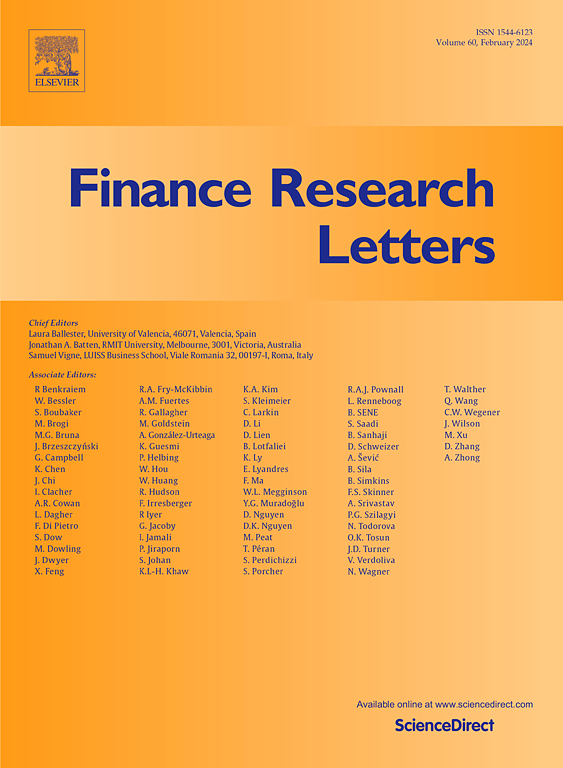更多信贷,更少增长的悖论:调查发展中国家的信贷增长之谜
IF 6.9
2区 经济学
Q1 BUSINESS, FINANCE
引用次数: 0
摘要
本文使用面板阈值回归模型(PTRMs)研究了2015年至2024年121个发展中国家的信贷增长之谜。它解决了两个关键问题:(i)信贷扩张在什么程度上开始阻碍经济增长?(二)制度质量如何影响这一阈值?该分析考察了在控制宏观经济、金融和制度因素的情况下,信贷对经济增长的影响在不同信贷与gdp比率下是如何变化的。基线模型确定了20%、40%和68%的阈值,增长效应在68%以上逐渐减弱。结合机构质量和金融深度控制,将这些门槛提高到79%,表明更强大的机构可以增强一个国家的信贷吸收能力。子样本分析证实了这一点。制度强大的国家门槛较高(73%),而制度较弱的国家门槛较低(49%)。为了解决内生性问题,两阶段最小二乘(2SLS)回归验证了这些非线性、制度依赖的信贷增长动态,强调了将信贷扩张与制度改革和金融部门加强相结合以实现可持续增长的重要性。论文最后提出了政策建议,敦促各国央行通过整合各国信贷与gdp之比的阈值来加强信贷监测,以便进行及时、有针对性的干预。本文章由计算机程序翻译,如有差异,请以英文原文为准。
The paradox of more credit, less growth: Investigating the credit-growth puzzle in developing countries
This paper investigates the credit-growth puzzle across 121 developing countries from 2015 to 2024 using Panel Threshold Regression Models (PTRMs). It addresses two key questions: (i) At what level does credit expansion begin to hinder economic growth? and (ii) How does institutional quality influence this threshold? The analysis examines how credit’s impact on growth changes at varying credit-to-GDP ratios while controlling for macroeconomic, financial, and institutional factors. The baseline model identifies thresholds at 20 %, 40 %, and 68 %, with growth effects diminishing beyond 68 %. Incorporating institutional quality and financial depth controls raises these thresholds to 79 %, indicating that stronger institutions enhance a country’s credit absorption capacity. Sub-sample analysis confirms this. Countries with strong institutions have a higher threshold 73 %, whereas those with weaker institutions face a lower threshold 49 %. To address endogeneity, a Two-Stage Least Squares (2SLS) regression validates these nonlinear, institution-dependent credit-growth dynamics, underscoring the importance of pairing credit expansion with institutional reforms and financial sector strengthening for sustainable growth. The paper concludes with policy recommendations, urging central banks to enhance credit monitoring by integrating country-specific credit-to-GDP thresholds for timely, targeted interventions.
求助全文
通过发布文献求助,成功后即可免费获取论文全文。
去求助
来源期刊

Finance Research Letters
BUSINESS, FINANCE-
CiteScore
11.10
自引率
14.40%
发文量
863
期刊介绍:
Finance Research Letters welcomes submissions across all areas of finance, aiming for rapid publication of significant new findings. The journal particularly encourages papers that provide insight into the replicability of established results, examine the cross-national applicability of previous findings, challenge existing methodologies, or demonstrate methodological contingencies.
Papers are invited in the following areas:
Actuarial studies
Alternative investments
Asset Pricing
Bankruptcy and liquidation
Banks and other Depository Institutions
Behavioral and experimental finance
Bibliometric and Scientometric studies of finance
Capital budgeting and corporate investment
Capital markets and accounting
Capital structure and payout policy
Commodities
Contagion, crises and interdependence
Corporate governance
Credit and fixed income markets and instruments
Derivatives
Emerging markets
Energy Finance and Energy Markets
Financial Econometrics
Financial History
Financial intermediation and money markets
Financial markets and marketplaces
Financial Mathematics and Econophysics
Financial Regulation and Law
Forecasting
Frontier market studies
International Finance
Market efficiency, event studies
Mergers, acquisitions and the market for corporate control
Micro Finance Institutions
Microstructure
Non-bank Financial Institutions
Personal Finance
Portfolio choice and investing
Real estate finance and investing
Risk
SME, Family and Entrepreneurial Finance
 求助内容:
求助内容: 应助结果提醒方式:
应助结果提醒方式:


